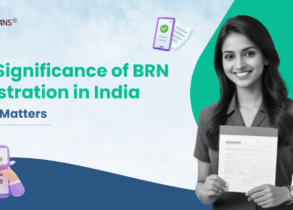Aug 06, 2024
Oct 01, 2025

Efficient financial management is essential for a growing SME in India. Pro forma invoice has proven to be an invaluable tool in this regard. A pro forma invoice is an initial bill of sale sent to buyers before the final invoice. This article explores how this simple yet powerful tool benefits your business.
What is a Pro Forma Invoice?
A pro forma invoice is a preliminary bill of sale sent to buyers in advance of delivery of goods or services. It’s important to note that it’s not a true invoice – the term “pro forma” means “for the sake of form”. A few characteristics of this invoice are as follows:
- The bank issues it before completing the transaction.
- It’s a good-faith agreement showing the expected details of the transaction. This means that parties in the business perform their obligation with honest intent and a genuine commitment.
- It’s subject to change and is not a demand for payment.
- It often acts as a sales quote or order confirmation.
A pro forma invoice template includes the following details:
- Seller’s and buyer’s contact information
- Date of issue
- Description of goods or services
- Quantities and prices
- Total amount due
- Payment Terms
- Delivery details
- Any applicable taxes or duties
Key Advantages of Pro Forma Invoice
1. Clarity in Transaction Details
Preliminary itemisation: It offers a detailed breakdown of goods or services you will provide, including quantities, descriptions, and individual prices. This allows the buyer to review the specifics before committing to the purchase.
Total cost projection: This invoice calculates and presents the total expected cost, including any taxes, shipping fees, or additional charges. It gives the buyer a clear picture of the full financial commitment.
Payment terms: It outlines the expected payment schedule, methods, and any specific conditions. This helps both parties align on financial expectations.
Customisation details: For custom orders, you can specify exact specifications, materials, or other tailored elements in your invoice. This ensures both parties are in agreement on the final product.
2. Facilitates Smooth Loan Application Process
Cash flow projection: By outlining future transactions, it helps in predicting the cash flow of your business. This becomes important for business loan repayment planning.
Business viability evidence: It shows the potential profitability of your business, supporting your case for business loan eligibility.
Risk assessment: Through this preliminary invoice, lenders can better evaluate the financial risks involved of the proposed business activity.
Collateral valuation: It helps estimate the value of goods that borrowers will use as collateral.
Transaction legitimacy: It serves as proof of a pending transaction, adding credibility to the business loan request.
Invoice financing: In some cases, businesses can use these invoices for invoice financing where a lender advances funds based on expected future payments. FlexiLoans offers upto ₹2.5 crore as a loan for business against your invoices that can fulfill any urgent capital requirement.
Working capital loan: They can support applications for short-term working capital loan by showing upcoming cash inflows.
3. Enhances Cash Flow Management
Advance planning: This invoice provides an estimate of future expenses or income. This allows you to anticipate cash flows and plan accordingly.
Faster payments: By sending this invoice before the final invoice, you give the customer advance notice of the expected charges. This allows them to prepare for payment and allocate funds. It becomes essential when you have ongoing term loans to repay.
Deposit collection: It facilitates requesting upfront deposits, and securing partial payment before work begins.
Budget forecasting: These invoices help in creating more accurate budget forecasts by providing detailed cost estimates.
Resource allocation: When a business considers multiple purchases, this preliminary invoice helps compare costs, allowing them to prioritise resource allocation based on expected expenses and potential returns.
Reduced payment delays: These invoices allow customers to review charges in advance and reduce payment disputes and delays.
4. Builds Credibility with Lenders
Financial projections: Estimates of future sales through pro form invoices help lenders assess an SME’s potential revenue and cash flow. This can also lead to favorable business loan interest rate.
Business planning: It shows that a company has thoroughly planned its operations and pricing strategy.
Industry knowledge: Accurate pro forma invoice reflects a deep understanding of the market and customer base.
5. Supports Budget Planning
Cost estimation: With the estimates of expected costs for goods or services through this invoice, you can accurately forecast expenses.
Budget adjustments: Pro forma invoices allow for early identification of potential cost overruns. This enables you to adjust your business budget timely.
Vendor negotiation: With handy preliminary information, you can negotiate better terms with suppliers before finalising purchases.
6. Reduces Errors and Disputes
Setting expectations: They set clear expectations for payment terms, delivery timelines, and other important factors, reducing the possibility of future disputes.
Opportunity for review: Buyers can carefully examine this invoice and raise any questions or concerns before committing to the purchase. This proactive approach helps arrest potential issues early.
Facilitating corrections: If you find errors in this invoice, they can easily correct them before issuing the final invoice. This prevents more complicated disputes later.
Documentation for reference: This invoice serves as a reference document that both parties can consult if questions arise during or after the transaction.
7. Compliance with Regulations
Customs declarations: These invoices provide detailed information about goods being shipped internationally. This helps customs officials accurately assess duties and taxes.
Foreign exchange controls: In countries with strict currency controls, these invoices help authorities track and approve foreign currency transactions related to international trade.
Anti-money laundering (AML) regulations: This preliminary invoice creates a paper trail that helps businesses comply with AML regulations by documenting the nature and value of transactions.
Tax compliance: They assist in proper GST accounting and provide a basis for tax reporting in cross-border transactions.
8. Facilitates price negotiations
Provides a clear starting point: This invoice outlines an initial price proposal, giving both parties a clear figure to begin discussions.
Enables comparison: Buyers can easily compare pro forma invoice from different suppliers, helping them negotiate better terms.
Highlights volume discounts: You can use this invoice to show how prices might change with different order quantities. This encourages buyers to go for large purchases.
Allows for revisions: As negotiations progress, the pro forma invoice can be easily updated to reflect new agreed-upon terms.
9. Aids in customs clearance
Preliminary documentation: These invoices serve as preliminary documents that provide key details about the incoming shipment before the supplier issues the final invoice. This allows Indian customs authorities to begin processing the shipment in advance.
Valuation assessment: Customs officers use the pro forma invoice to make an initial assessment of the goods’ value. This helps determine applicable duties and taxes.
Import license requirements: By reviewing this invoice, customs authorities can determine if the goods require any special import licenses or permits.
Facilitating Letters of Credit: Banks often require these invoices to issue letters of credit, which are important for many international transactions.
10. Encourages Growth and Expansion
Securing financing: Companies can use these invoices to demonstrate potential future income to lenders or investors. This can help secure funding for expansion projects or new ventures including msme loans.
Attracting new customers: These invoices give potential customers a clear understanding of costs upfront, which can help build trust and win new business. This is particularly valuable when expanding into new markets or customer segments.
Facilitating large orders: For businesses looking to take on larger projects, pro forma invoice help manage expectations and costs effectively, enabling growth into new areas.
Reducing financial risks: By clearly outlining terms and costs in advance, this invoice can help businesses avoid misunderstandings and financial disputes, reducing risks associated with expansion.
Enhancing professionalism: Using these invoices can make a business appear more professional and organised, which can be particularly beneficial when entering new markets or dealing with larger clients.
Conclusion
In today’s competitive business landscape, the usage of pro forma invoice can provide a significant advantage. From building credibility with lenders to supporting budget planning and ensuring regulatory compliance, these invoices play an important role in streamlining financial processes. They not only reduce errors and disputes but also aid in price negotiations and customs clearance for international trade.
FAQs
A pro forma invoice is an initial bill of sale sent to buyers before shipment or delivery of goods. It provides the buyer with the exact cost of the goods or services, including any taxes, shipping costs, or other charges.
1. A Pro Forma Invoice is issued by the seller before a sale is finalized to provide an estimate of costs, helping the buyer decide or for customs clearance, and it is not a demand for payment.
2. A Commercial Invoice is issued by the seller after a sale is completed, states the final and actual costs, and is used for collecting payment and for official customs valuation, as it is a formal demand for payment.
1. Start with a professional-looking template. Many accounting software packages offer these.
2. At the top, state your company name, address, contact details, and logo if applicable.
3. Make sure it’s marked as a pro forma invoice to distinguish it from a standard invoice.
4. Include the buyer’s name, company, address, and contact details.
5. Provide a unique invoice number and date.
6. List the products or services details such as description of goods or services, quantity, unit price, and total price for each line item.
7. Sum up all line items.
8. Include information about when and how payment is expected.
9. Include estimated shipping date, method, and any associated costs.
10. Note any special conditions such as insurance requirements or specific trade terms (like Incoterms for international shipments).
11. Clearly state that this is an estimated invoice and not a demand for payment.
12. Provide your signature.
Simplify your entrepreneurial journey today – apply for hassle-free and collateral free business loan with FlexiLoans in minutes!
Deprecated: Function get_the_author was called with an argument that is deprecated since version 2.1.0 with no alternative available. in /var/www/html/wordpress/flexiloans.com/blog/wp-includes/functions.php on line 6114
Deprecated: Function get_the_author was called with an argument that is deprecated since version 2.1.0 with no alternative available. in /var/www/html/wordpress/flexiloans.com/blog/wp-includes/functions.php on line 6114







